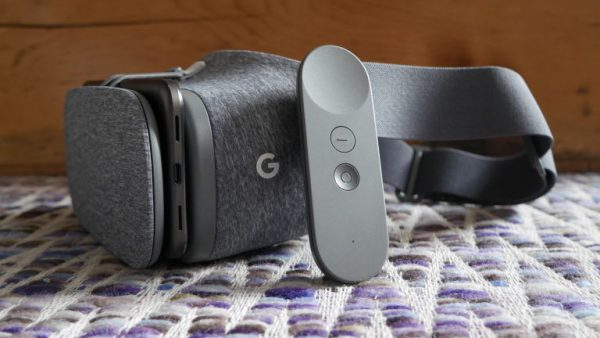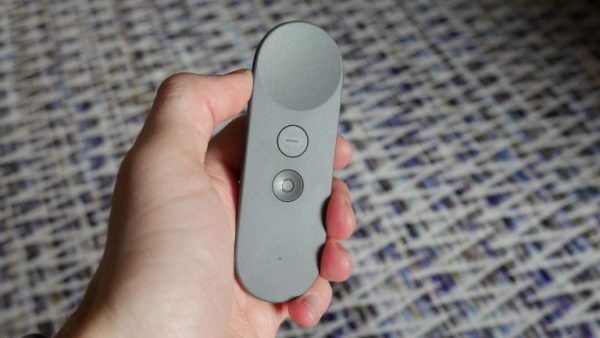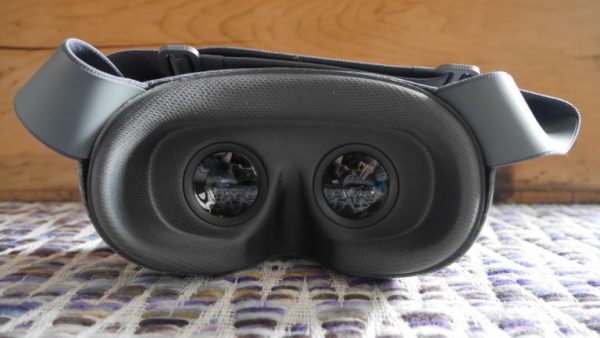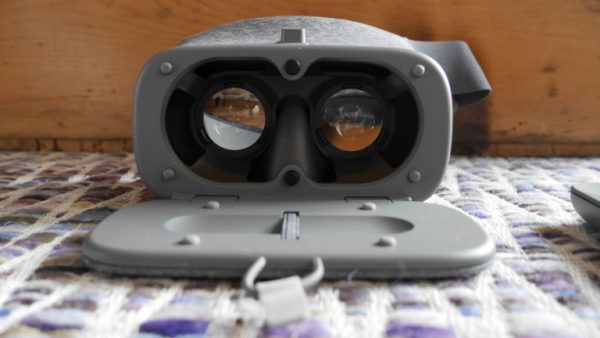Google Daydream View review: Is this VR headset the answer to accessible virtual reality?
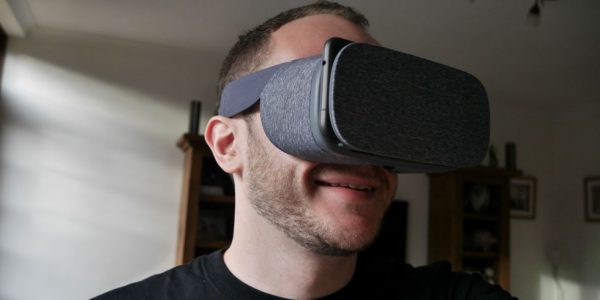
Welcome to the future. OK, maybe not the future – VR’s been around for a couple of years, after all – let’s just call it a more accessible future. One with automatic doors, ramps instead of stairs, and subtitles. The Google Daydream View is opening up VR to all, or at least not just those with a certain brand of handset. That’s key, because unlike high-end VR headsets, the ones that cost hundreds of pounds, the £69 Google Daydream View doesn’t have its own inbuilt screen.
Instead, you’ll need to slide your phone in front of the lenses much like the Samsung Gear VR, the headset it’s looking to kill. A follow-on to the company’s phenomenally successful and brilliantly basic Google Cardboard, the Daydream View is a more robust next step into the virtual world. It’s fun and affordable, but is the Daydream View the future of VR? We strapped in to find out.
Pros:
- Comfortable, cool design
- Affordable
- Brilliant controller
Cons:
- Limited VR experiences
- Still basic immersion
- Experiences are battery hogs
Google Daydream View Design: Cool and comfortable
VR headsets aren’t the coolest-looking bits of kit. We know, shock, right? Stumbling around with a big square block of plastic on your face screams one thing, and it ain’t fashion season. They’re nerdy-looking bits of kit. Or at least they were. No, the Daydream View won’t transform you into some sort of high-tech fashionista, but you’ll look less of a prat than you would wearing many of its rivals.
Why? Well, because it’s subbed out all that cheap, uninspired plastic and wrapped itself in something a whole lot cooler and more comfortable: fabric. A fabric gadget might not sound that cool, but this pulls it off. Not only does the cushioned inner make the Daydream View a more comfortable bit of kit to strap to your face – especially during long sessions – the T-shirt-like material gives this headset a cool, unique finish, in each of its colour options. What’s more, although we’ve only been using the headset for a week, it feels like it will wear and age quite well, too.
In terms of overall user experience, it’s got nothing on the HTC Vive. But one thing it does have on the best VR headset money can buy, however, is its lack of cables. The Daydream View’s completely wireless form means it can be used anywhere, anytime. Comfortably. What’s more, when you’re done walking around a VR world, simply chuck it in your bag and take it to your mates for a play.
Overall, it really is a design win. Even the accompanying controller – that’s right, the peripherals won’t cost you extra here – is an elegant addition. The small, pebble-like accessory features a pair of circular buttons centred beneath a touch-sensitive panel with volume toggles on the side. Pleasingly, the controller can be stored within the headset while not in use too thanks to a handy strap.
If we were to find fault with the View’s design, it’s perhaps a little bit too small. Although meaning kids will be able to use it just fine, its snug fit can feel a little too snug at times, with the headset squishing your face in to its compact confinements.
Google Daydream View Features, Performance & Controller: Simple but effective
Intimidated by VR? Don’t be. The Google Daydream View is a joy to use from the off. Setting it up is as simple as launching the Daydream app on your compatible phone and strapping it in. That’s it. There’s no connection ports or fiddly frames to adjust, just a little bungee-cord lock that will keep your phone firmly wedged in place. There is a pretty major restriction though: only the Google Pixel and Pixel XL are currently supported. A mass of new compatible devices are coming, but not until the New Year.
Once in, you’re off: move your head and the virtual world is open for you to look around. Whether you’re strolling around a VR Street View experience or entering a game, your head movements are transformed into real actions thanks to the sensors within the phone. Once you’ve got it focussed, that is. Instead of having a handy focus dial like the Gear VR, you’ve got to tilt the headset itself up and down to calibrate the view to you. If, like us, you usually wear glasses, this can be a lengthy process.
It’s not just about the headset, though. The real star of the show here is the accompanying controller. The small, simple, single-handed controller takes you from a passive VR experience to an active, engaging and engrossing one. Again syncing wirelessly without any faffy setup, it lets you effortlessly interact with your surroundings thanks to the controller’s physical buttons and positional awareness. Move your hand and a dot on the screen will show where you’re pointing. In many apps the controller digitally transforms into some form of in-action peripheral.
It’s not faultless. Trying to manipulate 3D worlds can result in a lot of unnatural wrist contortion as the controller struggles to accurately track movements across multiple axis simultaneously. For the most part, however, its point, click, move mechanism is a welcome and effective hit more than a reality-warping miss.
The Daydream View might work well, but it’s not got a lot to work with. As with any VR headset, its main downfall is a pretty big and unsurprising one – its lack of compatible content. Unless you’re happy simply wandering the world’s landmarks in VR Street View or plodding around the Natural History Museum looking at fossils and whales, you’re going to get bored pretty quickly.
VR porn aside, gaming is what many will be hoping to indulge in when snapping up a Daydream View. The options here though are even more restrictive. We’re talking three day-one titles. Worryingly, the kid-friendly Wonderglade – a mini-game filled theme park – is the most entertaining. These selection of mini-games – anyone for a round of crazy golf? – are enjoyable and will get you smiling and challenging mates. You’re not going to be coming back for another play day after day though.
Similarly, the puzzle-based, robot-moving Mekorama is fun but repetitive and the more graphically impressive, battler Hunters Gate is troubled by a bitty interface and confusing control mechanism. The result is a headset that will be fun at the start, but won’t have you pitching into the virtual realms.
Overall, the sparse collection of VR experiences and games that are available are fine. Not great, but decent. The main trouble is that they’re not really pushing anything forward. There’s nothing you can’t do on the Gear VR or Cardboard. The only difference here is that the remote lets you feel like you’re more engaged with what you’re looking at.
Google Daydream View Verdict: Great, but pretty limited
The Samsung Gear VR has been the driving force for portable, accessible VR in recent years. Not anymore. The Google Daydream View has it beat on all fronts, apart from the one that really matters: content. Having ditched the plastic for softer, more cushioned materials, it’s more comfortable and stylish than the Gear, but at the moment there’s not enough content to get you picking one over the other.
The Daydream View is a great device, but not for now. This is a device for the future. Its wallet-friendly £69 asking price will make VR accessible to all when more phones are supported, and the controller will be a defining addition when there is decent content to make use of it. As we’ve said many times before, VR is coming, it’s just a long road. Sadly, the View has only taken a small step to speed this up.



